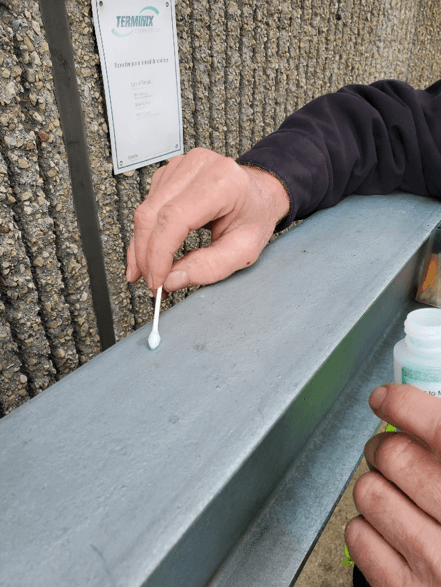BY LAURA BLECHL
Welcome to the Inspector’s Corner Series of DECO Coatings. This series will offer quarterly tips, advice, and insight from an inspector’s perspective. Let’s get nerdy!

Disclaimer: topics and advice are all from the opinion of DECO Coating’s in-house inspector and apart of DECO Coatings best practices. Some topics may not be enforceable by specification, only to act as a guide in assessing coating failures and performing basic tests. Every project is unique, and any inspector or contractor shall always refer to job specification and referenced standards.
PASSIVATOR TEST
What is it?
Passivator test consists of a clean cotton swab and copper sulfate test solution. Passivation is a quenching process on galvanized steel that prohibits the formation of excessive zinc oxides and zinc hydroxides during its first six weeks1. Because this passivation layer is clear, it cannot be detected with a simple visual inspection.
Why is it important?
It is critical that a powder or liquid coating applicator know if a passivator exists prior to performing coating operations, or adhesion problems are likely to occur. Often there are gaps in communication between steel fabricators with galvanized material to finish paint, thus causing finger-pointing or “blame-game” when things go wrong. It is imperative that if a galvanized substrate is to be coating (duplex coating) than testing for passivation shall occur. Typically, responsibility of coating contractor as a quality control practice.
Does it affect job cost?
There is minimal cost associated to perform the test, often it takes more time to access the substrate then to perform the test itself. However, compared to possible costs associated with potential adhesion failure – this is time well spent!
How is it performed?
Clean test area with water based cleaner or solvent-based cleaner (xylene). Once dry, test area with coffer sulfate solution. Dip cotton swab in solution, apply to substrate, wait 5 seconds. Area should turn dark gray if NO passivator is present. If nothing changes, do second test method.


Second test method: Lightly scratch area with green scotch brite scoring pad, then apply new swab. Wait 5 second – area should turn dark gray. Proceed with recommended cleaning agent to remove passivation prior to coating.


Referenced Standards?
None specifically for testing to galvanized substrates for painting. There is a copper sulfate test by ASTM (F1089), more applicable to testing to surgical instruments.
With no official standards – do not let that prevent you from writing in specification or summaries of work – a simple addition of a test will protect your asset and provide quality assurance.
Next Steps?
Always check with coatings manufacturer or supplier for the best method for treatment of galvanized substrate prior to coating. If passivator is present, typically a cleaning etch or other agent is introduced to the cleaning task. Surface must be cleaned after treatment to ensure no residue to film is left on surface prior to coating.
Summary:
Performing a 5 second test will reduce blame game with an issue of coating failure/adhesion is found. It shall be the responsibility of the owner/engineer to enforce such test. Contractors shall be responsibility to perform test and communication with owner/engineer of results and solutions. DECO Coatings best practices always includes a swab test for any painting over galvanized projects (duplex coatings). Contact the nerds today!